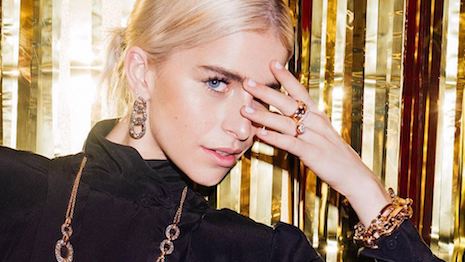- About
- Subscribe Now
- New York,
October 25, 2018

 Pomellato has the most positive sentiment of brands studied. Image credit: Pomellato
Pomellato has the most positive sentiment of brands studied. Image credit: Pomellato
Pomellato, John Lobb and Van Cleef & Arpels are among the luxury accessories labels with the most positive social media sentiment, according to a new report from NetBase.
Accessories are a significant portion of the personal luxury goods market, with products such as handbags and footwear representing almost two-thirds of sales, according to Bain. While these categories are seeing strong growth, NetBase's 2018 Europe Luxury Accessories Social Sentiment Report points to the potential for brands to drive more loyalty through social media strategies that center on listening to what shoppers are saying.
"The luxury market is seeing a generational shift, with 85 percent of luxury growth in 2017 fueled be the younger generations," said Paige Leidig, chief marketing officer at NetBase.
"Social media, in particular Instagram, is certainly impacting the market in a big way, and so too, are millennials," he said. "But are you preparing for Gen Z as well? Many are not."
Accessories approach
Per Bain, 85 percent of luxury growth today is coming from millennials and Gen Z consumers. This younger base is behind rising trends such as streetwear, sneakers and T-shirts.
As these up-and-coming consumers increasingly become luxury buyers, it is important for brands to reach out to an aspirational audience on social media. In the crowded space, content such as exclusive videos, influencer marketing and long-form storytelling can help set brands apart.
For instance, Miu Miu's commissioned Women's Tales offer the brand the chance to share exclusive cinematic creations with its audience (see story).
NetBase compared the net sentiment for accessories categories with other high-end categories. While beauty has the most positive presence on social media at 83, jewelry is close behind with a score of 82.
John Lobb's Willow boot for women. Image credit: John Lobb
Leading the brand rankings for the 39 houses studied, Pomellato had a near-perfect score of 99, meaning that 99 percent of the conversation around its brand is positive. Labels including John Lobb, Van Cleef & Arpels, Jaeger-LeCoultre, Vacheron Constantin, Emilio Pucci and Chopard also scored above 90.
While Gucci often tops lists of the brands getting significant attention, particularly among younger shoppers, NetBase found that the brand net sentiment is only 54. Similarly, labels including Chloé, Hermès and Brioni have sentiment scores of 60 or below.
NetBase notes that this either means there are significant negative sentiments being shared on social media, or that those who do post positively do not show as strong a degree of passion.
For all brands, NetBase points to the importance of listening, allowing marketers to learn what consumers are reacting to so they can adjust their strategies accordingly.
Luxury brands should also consider what their conversation is about. As an example, when comparing mentions of Coach to luxury labels such as Louis Vuitton and Gucci, the U.S. label sees more talk of discounts, which hurts its sentiment score.
Gucci is popular, but its sentiment score falls behind other brands. Image courtesy of Gucci
"Important first to understand who your target is and what values they have in order to maximize the impact of the human touch," Mr. Leidig said. "Louis Vuitton, for example, targets the ultra-exclusivity niche – and it does so very well."
The percentage of positive mentions for a particular brand also does not tell the full story. Labels with a niche, highly passionate audience may struggle to compete with mega brands who earn a greater volume of mentions that are both positive and negative.
According to NetBase research on European brands, only 46 percent of marketers in the region feel it is important to respond to negative comments. However, taking actions related to dissent can help brands retain customers and avoid losing them to competitors.
Passion progress
Toyota Corp.’s Lexus has wielded social media this past year to elicit favorable impressions from users, rising 31 spots in NetBase’s Top 100 Global Brand Love List.
The report shows that the most loved brands are those that dive into what it is about the marketer that consumers adore so much. Social media channels themselves have been able to wield this notion more so than others, taking up four spots among the top 10 most loved brands (see story).
Beyond impacting consumer-facing strategies, sentiment can point towards a brand's financial performance.
Social media, particularly Instagram, is crucial to understanding luxury brand performance including investment purposes, according to a new report from UBS.
UBS combined Instagram data with Google Search trends for a more complete analysis of the momentum behind luxury brands. The Facebook-owned platform continues to evolve, making it more important for heritage retailers to engage their social audiences (see story).
"Other luxury brands can learn from leading accessory players is that sentiment tells you everything about the consumers you hope to reach, what they want from you, what they want from competitors and how badly they want it," Mr. Leidig said. "Without sentiment, you are walking through a dark room, hoping not to bump into the furniture. With it, you are basking in the light of consumer knowledge.
"Use it to connect with people, not keywords, when creating your campaigns," he said. "The full social conversation will take you – and your marketing budget – well beyond the expected audience you’ve been targeting. With a little digging, you’ll uncover lookalike segments in other parts of the world."
Share your thoughts. Click here